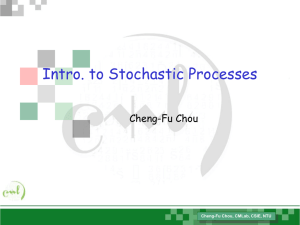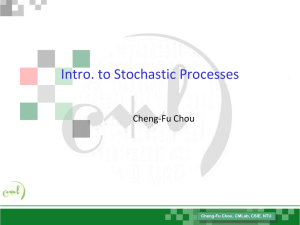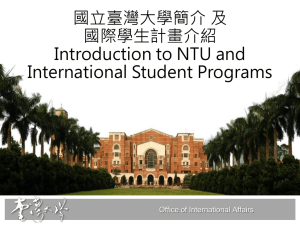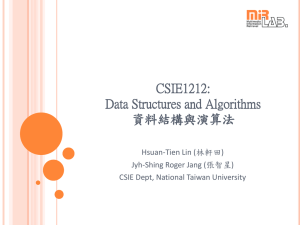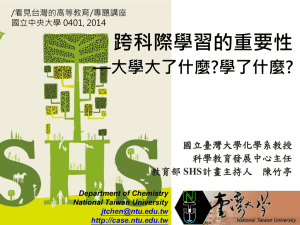Introduction
advertisement
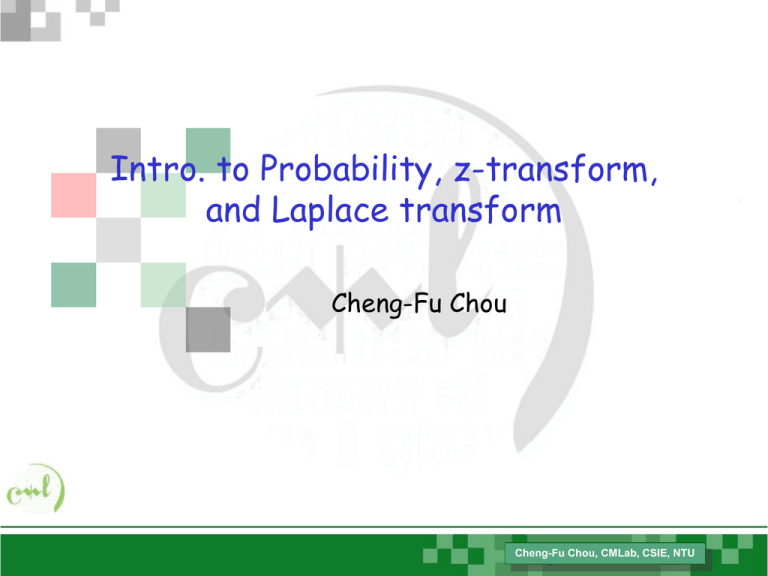
Intro. to Probability, z-transform,
and Laplace transform
Cheng-Fu Chou
Cheng-Fu Chou, CMLab, CSIE, NTU
Outline
Probability system
Conditoinal prob.
Theorem of total prob.
Bayes’ theorem
z-transform
Laplace transform
P. 2
Cheng-Fu Chou, CMLAB, CSIE, NTU
Probability
Sample Space (S) which is a collection of objects.
Each is a sample point.
A family of event S = {A, B, C, …} where a event is a
set of sample points.
A Probability measure P is an assignment (mapping) of
events defined on S into the set of real numbers.
– P[A] = Probability of event A
P. 3
Cheng-Fu Chou, CMLAB, CSIE, NTU
Properties
0 P[A] 1
P[S] = 1
If A and B are mutually exclusive, then P[A B] =
P[A] + P[B]
P. 4
Cheng-Fu Chou, CMLAB, CSIE, NTU
Notations
Event
– A = {w: w satisfies the membership property for
the event A}
Example
– dice
P. 5
Cheng-Fu Chou, CMLAB, CSIE, NTU
Ac is the complement of A where { w: w not in A}
A B = {w: w in A or B or both} = Union
A B = {w: w in A and B} = Intersection
0 = empty set
P. 6
Cheng-Fu Chou, CMLAB, CSIE, NTU
In general
Let A1, A2, …, An be events
P. 7
Cheng-Fu Chou, CMLAB, CSIE, NTU
Conditional Prob.
Cond. Prob.
– Constraint sample space
– Scale up
P. 8
Cheng-Fu Chou, CMLAB, CSIE, NTU
Ex. 1
P. 9
Cheng-Fu Chou, CMLAB, CSIE, NTU
Ex. 2
P. 10
Cheng-Fu Chou, CMLAB, CSIE, NTU
Statistical Independent
P. 11
Cheng-Fu Chou, CMLAB, CSIE, NTU
Bayes’ Theorem
Bayes’ Theorem: we can look at the problem from
another perspective. Assume we know event B has
occurred, but we want to find which mutually
exclusive event has occurred.
P. 12
Cheng-Fu Chou, CMLAB, CSIE, NTU
Ex. 1
Assume that 15% of job is from I.E., 35% of job is
from E.E., 50% job is from C.S.I.E.. Probability of
read news are 0.01, 0.05, and 0.02 respectively.
– P[a job chosen in random is a Read new jobs]
– P[a randomly chosen job is from EE | it is a read
news job]
P. 13
Cheng-Fu Chou, CMLAB, CSIE, NTU
P[read] = 0.15*0.01+0.35*0.05+0.5*0.02
P[read from E.E./read] = (0.35*0.05)/P[read]
P. 14
Cheng-Fu Chou, CMLAB, CSIE, NTU
Ex. 2
When you walk into a casino, it is a equal prob. for you
to play with honest player or a cheating player. The
prob. for you to lose when playing with a cheating
player is p. Find the
– Prob.[playing with a cheating player | you lost]
P. 15
Cheng-Fu Chou, CMLAB, CSIE, NTU
P[playing with a cheating player / you lost]
= 0.5*p/(0.5*0.5+0.5*p)
P. 16
Cheng-Fu Chou, CMLAB, CSIE, NTU
Bernoulli trials
A random experiment that has two outcomes:
“success”: p or “failure” : q (= 1 - p). Now consider a
compound sequence of n independent repetition of
this experiments. This is known as Bernoulli trials.
– What is the prob. of exactly k successes after n
trials ?
– Verification:
P. 17
Cheng-Fu Chou, CMLAB, CSIE, NTU
n k nk
(1) p (k ) p q
k
n
n
n k nk
(2) p (k ) p q ( p 1 p ) n 1
k 0
k 0 k
P. 18
Cheng-Fu Chou, CMLAB, CSIE, NTU
The Birthday Problem
In probability theory, the birthday paradox states
that given a group of 23 (or more) randomly chosen
people, the probability is more than 50% that at least
two of them will have the same birthday. For 60 or
more people, the probability is greater than 99%.
– Prove them.
P. 19
Cheng-Fu Chou, CMLAB, CSIE, NTU
Birthday problem (cont.)
assume there are 365 days in a year
p is the prob. that no two people in a group of n people
will share a common birthday
– p = (1 – 1/365)(1 – 2/365) …(1 – (n-1)/365)
– p < ½ as n is 23
– P < 0.01 as n is 56
P. 20
Cheng-Fu Chou, CMLAB, CSIE, NTU
Monty Hall Problem
Based on the American game show “Let’s Make a Deal”
– Suppose you're on a game show, and you're given
the choice of three doors: Behind one door is a car;
behind the others, goats. You pick a door, say No. 1,
and the host, who knows what's behind the doors,
opens another door, say No. 3, which has a goat. He
then says to you, "Do you want to pick door No. 2?"
Is it to your advantage to switch your choice?
P. 21
Cheng-Fu Chou, CMLAB, CSIE, NTU
Random Variables (r.v.)
We have the probability system (S, S, P)
R.v. is a variable whose value depends upon the
outcome of the random experiment.
The outcomes of our random experiment is a w S.
We associate a real number X(w) to w.
Thus, the r.v. X(w) is nothing more than a function
defined on the sample space S.
P. 22
Cheng-Fu Chou, CMLAB, CSIE, NTU
Probability distribution function
P. 23
Cheng-Fu Chou, CMLAB, CSIE, NTU
Probability density function
pdf:
Different ways to view pdf:
P. 24
Cheng-Fu Chou, CMLAB, CSIE, NTU
Special discrete dist.
The Bernoulli pmf
The Binominal pmf: n independent bernoulli trials.
P. 25
Cheng-Fu Chou, CMLAB, CSIE, NTU
Geometric Dist.
Sequence of bernoulli trials, but we count no. of trials
until First success
– P(i) = P(x=i) = (1-p) i-1 p
– For Geometric dist., it has markov property or it is
memoryless: P[x = i + n | x >n } = P[ x = i]
P. 26
Cheng-Fu Chou, CMLAB, CSIE, NTU
Special Continuous Dist.
Exponential r.v.
– A continuous r.v. for some l > 0
f(x) = l e –lx if x 0
0
x<0
– For exponential dist., it has Markov property or it
is memoryless
P. 27
Cheng-Fu Chou, CMLAB, CSIE, NTU
Question
How could we generate a sequence number x1,
x2, …,xn such that xi is a exponential (or any
other specific dist.) r.v. with parameter l?
P. 28
Cheng-Fu Chou, CMLAB, CSIE, NTU
Inverse-transform Technique
The concept
– For cdf function: r = F(x)
– Generate r from unifrom (0,1)
– Find x such that x = F-1(r)
P. 29
Cheng-Fu Chou, CMLAB, CSIE, NTU
Ans
P. 30
Cheng-Fu Chou, CMLAB, CSIE, NTU
PDF for 2 R.V.
FXY ( x, y ) P[ X x, Y y ];
2
d FXY ( x, y )
f XY ( x, y )
dxdy
Marginal Density Function
P[ x1 X x2 , y1 Y y2 ]
x2
x1
y2
y1
f XY ( xy )dydx
Independent : FXY ( xy ) FX ( x) FY ( y ) Prob[X x]Prob[Y y]
FXY ( x, y )
FX |Y ( x | y )
Prob[ X x | Y y ]
FY ( y )
P. 31
Cheng-Fu Chou, CMLAB, CSIE, NTU
Function of Random Variable
Func. of r.v.
Y g( X )
FY ( y) P[Y y ] P[{w : g ( X (w)) y}]
One important r.v. is where Xi are independent
n
Y Xi
i 1
P. 32
Cheng-Fu Chou, CMLAB, CSIE, NTU
Y = X1 + X2
PDF
FY ( y ) P[Y y ] P[ X 1 X 2 y ]
y x2
f ( x x )dx dx
[
f ( x )dx ] f ( x )dx
F ( y x ) f ( x )dx
f ( y) f ( y x ) f ( x )dx
X1 X 2
1 2
1
2
y x2
X1
1
1
X2
2
2
pdf
2
X2
2
2
Y
Convolution
X1
X1
2
X2
2
2
fY ( y) f X1 ( y) f X 2 ( y)
P. 33
Cheng-Fu Chou, CMLAB, CSIE, NTU
Convolution Ex.
• f(n)
• 2/3 as n = 1
• 1/3 as n = 2
• g(n)
• 1/2 as n = 1
• 1/2 as n = 2
h(n) = f(n)g(n) = ?
P. 34
Cheng-Fu Chou, CMLAB, CSIE, NTU
Ex. (cont.)
h(0) = f(0)g(0) = 0
h(1) = f(1)g(0) + f(0)g(1) = 0
h(2) = f(2)g(0) + f(1)g(1) + f(0)g(2) = 1/3
h(3) = f(3)g(0)+f(2)g(1)+f(1)g(2)+f(0)g(3) = ½
h(4) = f(4)g(0)+f(3)g(1)+f(2)g(2)+f(1)g(3)+f(0)g(4) =
1/6
P. 35
Cheng-Fu Chou, CMLAB, CSIE, NTU
z transform
Consider a func. Of discrete time fn s.t.
– fn 0 for n = 0, 1, 2, …
– fn = 0 for n = -1, -2, …
–
f n F ( z )where F ( z ) n 0 f n z
n
P. 36
Cheng-Fu Chou, CMLAB, CSIE, NTU
Examples
Ex1:
f n A n forn 0,1, 2,...
n 0
n 0
F ( z ) A n z n A ( Z ) n
z
Ex2:
n
Convolution property f n gn f nk gk
k 0
P. 37
Cheng-Fu Chou, CMLAB, CSIE, NTU
Convolution Property
n
f n g n [ f n k g k ]z n
n 0 k 0
n
[ f n k g k ]z n k z k
n 0 k 0
[ g k z k ] f n k z n k
k 0 n k
k 0
nk
k 0
m0
g k z k f n k z n k
g k z k f m z m
G ( z ) F ( z )
P. 38
Cheng-Fu Chou, CMLAB, CSIE, NTU
Properties of z transform
1. f n F ( z ) f n z n
n 0
2.af n bg n aF ( z ) bG ( z )
3.a n f n F (az )
4. f n 1
n 0
1
1
n 1
f n 1 z f n 1 z [ F ( z ) f 0 ]
z n 0
z
n
5. f n 1 f n 1 z z f n 1 z n 1 zF ( z )
n
n 0
n 0
6.nf n nf n z
n
n 0
n 0
dz n
d
fn
z z F (z)
dz
dz
7. f n g n F ( z )G ( z )
P. 39
Cheng-Fu Chou, CMLAB, CSIE, NTU
Properties (cont.)
8. f n f n 1 F ( z ) zF ( z ) (1 z ) F ( z )
n
n
9. f k , n 0,1, 2,... f k z f k z z
n
k 0
n 0 k 0
k
k 0 n k
nk
F ( z)
1 z
10. f n (n is a parameter of f n )
F ( z)
a
a
11.F (1) f n
n 0
12. F (0) f 0
P. 40
Cheng-Fu Chou, CMLAB, CSIE, NTU
z Transform pair
1n 0
1.U n
F ( z) 1
0
otherwise
2.U n k z k
3. n 1 forn 0,1,... z n
n0
4. n k
zk
1 z
5. A A n z n
n
n 0
6.n n
7.n
1
1 z
A
1 z
z
(1 z ) 2
z
(1 z ) 2
1
zn
8. F ( z ) e z
n!
n 0 n !
Read and derive Table I.1 and I.2
P. 41
Cheng-Fu Chou, CMLAB, CSIE, NTU
z transform : difference equation
Ex:
6 g n 5 g n 1 g n 2
1 n
6( ) n 2,3, 4,...
5
6
g 0 0; g1
5
P. 42
Cheng-Fu Chou, CMLAB, CSIE, NTU
z-transform and moment
G( z) f n z n
n 0
dG ( z )
dG ( z )
n 1
nf n z
dz
dz
n 0
z 1
nf n X
n 0
d 2G ( z )
n2
n
(
n
1)
f
z
n
2
dz
n 0
d 2G ( z )
dz 2
2
2
(
n
n
)
f
X
X
z 1
n
n 0
P. 43
Cheng-Fu Chou, CMLAB, CSIE, NTU
Laplace transform
Def:
1.F *( s )
st
f (t )e dt ;
2. f (t ) F *( s )
Ex 1.
Ex 2.
Ae at t 0
f (t )
0otherwise
1 t 0
(t )
0 t 0
P. 44
Cheng-Fu Chou, CMLAB, CSIE, NTU
Convolution
f(t) and g(t) take on non-zero values for t 0
f (t ) g (t )
f (t x) g ( x)dx
P. 45
Cheng-Fu Chou, CMLAB, CSIE, NTU
Properties
1. af (t ) bg (t ) aF *( s) bG *( s)
t
2. f ( ) aF *(as)
a
3. f (t a) e as F *( s)
4. e at f (t ) F *( s a )
d
5. tf (t ) F *( s )
ds
n
d
F *( s )
n
n
6. t f (t ) (1)
ds n
f (t )
7.
F *( s1)ds1
s1 s
t
P. 46
Cheng-Fu Chou, CMLAB, CSIE, NTU
Properties (cont.)
df (t )
8.
?( sF *( s) f (0 ))
dt
d n f (t )
n
n 1
n 1
9.
s
F
*(
s
)
s
f
(0
)
...
f
(0
)
n
dt
t
F *( s)
10. f (t )dt
s
t
t
F *( s)
n
11. ... f (t )(dt )
sn
P. 47
Cheng-Fu Chou, CMLAB, CSIE, NTU
Differential eq.
Find f(t)
d 2 f (t ) 6 f (t )
9 f (t ) 2t ;
2
dt
dt
df
(0
)
f (0 )
0;
dt
P. 48
Cheng-Fu Chou, CMLAB, CSIE, NTU
Random Sum
Given Y X 1 X 2 ... X N~ , find Y
~
X i are i.i.d. N is a discretenon - negat iver.v.
~
~
Y * (s) Y * (s | N n)P [N n]
n 0
~
Y * (s | N n) [X * (s)]n
~
Y * (s) [X * (s)] P [N n]
n
n 0
~
Note that N ( z ) P[ N n]z n
n 0
Relatez with [X * (s)]n
Y * ( s ) N [ X * ( s )]
P. 49
Cheng-Fu Chou, CMLAB, CSIE, NTU
Ex.
Y X 1 X 2 ... X N~
X i are i.i.d. exponential dist ribut ed,
~
N is geomet rically dist ribut ed.
(1) Find E[Y].
(2) Whatis var[Y]
P. 50
Cheng-Fu Chou, CMLAB, CSIE, NTU
